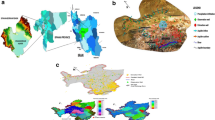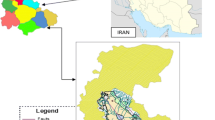Abstract
Agriculture sector by using 80% of freshwater is the greatest water consumer in Iran. Excessive use of agricultural fertilizers in last decade, caused accumulation of enormous amounts of salts and subsequence declined the physical properties of soil. In desert and dry regions such as Rafsanjan plain, use of the groundwater resources is more than the surface water resources. Therefore, information about the quality of these resources remains a necessary task for optimum management, protection of water resources, and stopping the future damages. In this study, the groundwater quantity and quality of Rafsanjan plain was investigated by MODFLOW and MT3DMS. The presented quantitative model for this aquifer was compared by observed data and calibrated. This model was used to predict a 10-year period. Results show that water elevation decreases approximately 15 m for 10 years to come in this plain. Qualitative model results show that most quality parameters will increase. Electrical conductivity will increase more than other parameters. As values of this parameter will reach 16,000 µs/l for next 5 years. Therefore, we suggest that exploitation of water from these resources should be reduced and discharge from some of agricultural wells stop; also we suggested that recharge to groundwater resources should be increased and agricultural activities should be limited or improved using of modern irrigation systems in this plain.













Similar content being viewed by others
References
Almasri MN, Kaluarachchi JJ (2007) Modeling nitrate contamination of groundwater in agricultural watersheds. J Hydrol 343:211–229
Anderson MP (1979) Using models to simulate the movement of contamination trough groundwater flow systems. CRC Critic Rev Environ Cont 9(2):97–156
Anderson MP (1984) Movement of contaminants in groundwater: groundwater transport—advection and dispersion, groundwater contamination. National Academy Press, Washington, DC, pp 37–45
Chiang WH, Kinzelbach W (1998) User’s manual of processing Modflow. Hamburg, Zurich, 331p
Chunmiao Zheng P (1999) User’s Manual of MT3D.University of Alabama.220 p
Gelhar LW, Welty C, Rehfeldt K (1992) A critical review of data on field-scale dispersion in aquifer. Water Resour Res 26(8):1707–1719
Mc Donald and Harbough AW (1988) MODFLOW: a modular 3D finite difference groundwater flow model. US Geological Survey, Open-File Report 83-875 (Chapter A1)
Kazemi F, Rahnama MB (2006) Modeling of groundwater in Rafsanjan aquifer and investigation of groundwater discharge effects. Thesis. Shahid Bahonar Kerman Iran University
Schwartz F, Zhang H (2003) Fundamentals of groundwater. Wiley, New York
Xu M, Eckstein Y (1995) Use of weighted least-squares method in evaluation of the relationship between dispersivity and field scale. Groundw 33(6):905–908
Zheng C, Bennett GD (1995) Applied contaminant transport modeling: theory and practice. Van No strand Rein hold, New York, 440p
Author information
Authors and Affiliations
Corresponding author
Rights and permissions
About this article
Cite this article
Rahnama, M.B., Zamzam, A. Quantitative and qualitative simulation of groundwater by mathematical models in Rafsanjan aquifer using MODFLOW and MT3DMS. Arab J Geosci 6, 901–912 (2013). https://doi.org/10.1007/s12517-011-0364-x
Received:
Accepted:
Published:
Issue Date:
DOI: https://doi.org/10.1007/s12517-011-0364-x




